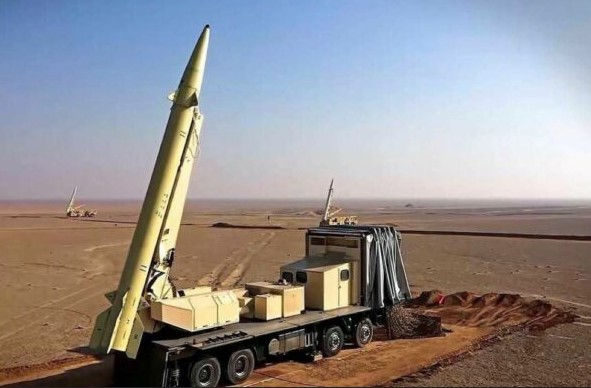In a dramatic and dangerous turn of events, Iran launched a massive retaliatory strike against Israel early Saturday morning.
Iran Strikes Back with Zolfaghar Missiles and Shahed Drones
This came just hours after Israel had carried out powerful air attacks on key Iranian sites. Those Israeli strikes reportedly killed several top generals and targeted nuclear and military facilities deep inside Iran. In response, Iran fired a barrage of Zolfaghar ballistic missiles—known for their destructive power and long range—alongside deadly drones aimed at Israeli targets.
Iran’s response was swift and serious. The Islamic Republic launched a series of powerful missiles and drones toward Israel. These attacks were not just symbolic—they were designed to cause real damage. Iranian media showed video clips of drones and missiles being launched from bunkers built into mountain ranges. These were not ordinary weapons. The drones were from the Shahed family, and the missiles were called Zolfaghar, both known for their deadly capabilities.
The situation became even more intense after Iran’s Supreme Leader, Ayatollah Ali Khamenei, made a public speech. He promised to bring destruction upon Israel in response to the earlier airstrikes. His speech reflected how serious Iran considered the attack by Israel. In reply to Iran’s missile barrage, Israeli Prime Minister Benjamin Netanyahu made a public statement, urging the Iranian people to rise against their government and warned that more attacks were on the way.
What Are Shahed Drones?
The Shahed drones used by Iran are a kind of flying weapon. They are called “kamikaze” or “suicide drones” because they crash into their target and explode. These drones are not just flown for spying; they are made to destroy. The most known ones are the Shahed-136 and the smaller Shahed-131. Iran builds these drones to be cheap but deadly.
They are tiny, triangular in shape, and have paper airplane-like wings. They have a spinning propeller at the back, which makes a buzzing sound like a moped or lawn mower. That’s how people can sometimes hear them coming. Despite their strange sound, they can be very hard to shoot down.
These drones are built using basic parts, some of which are bought from regular stores. This makes them easy to produce in large numbers. It may take them hundreds or even thousands of kilometers to reach their destination. The Shahed-136 has a 2,500-kilometer range. Some reports even say upgraded versions can go as far as 4,000 kilometers.
The Shahed drones carry explosives inside them. They dive into the target and blow it up once they get there. They can be filled with different kinds of bombs—some that spread shrapnel, others that cause massive fireballs, or ones that destroy buildings. Because they are so cheap and easy to make, Iran can launch many at once. When these drones are used in groups or “swarms,” they can overwhelm air defense systems and hit important buildings or power stations.
In this latest attack, these drones were seen taking off from inside mountain bunkers. This shows Iran planned this strike carefully and used hidden places to launch the attack.
Zolfaghar Missiles: A Threat from the Ground
Along with the Shahed drones, Iran also fired powerful Zolfaghar ballistic missiles at Israel. These are not regular missiles. Zolfaghar is a short-range, solid-fueled missile developed by Iran. They can travel up to 700 kilometers, enough to easily reach parts of Israel from Iranian territory.
The Zolfaghar missile is unique since it runs on solid fuel. This means it can be moved and launched more quickly than older, liquid-fueled missiles. It can be placed on a truck or mobile launcher, which helps Iran hide it and move it easily to different locations.
Each missile can carry a heavy warhead weighing up to 600 kilograms. That’s almost as heavy as a small car. These warheads are designed to explode on impact and cause massive destruction. Some versions of the missile are said to carry smaller bombs inside that scatter over a large area when the missile explodes. This makes them even more dangerous.
The Zolfaghar missile is also hard to stop. It has a detachable warhead, which can separate from the rest of the missile as it nears the target. This makes it tricky for enemy radar systems to lock on and destroy it in the air. Satellite navigation systems and internal sensors work together to guide the missile. Some types even have cameras or optical systems to help them hit the target more accurately.
Iran Orders Massive Shipment of Missile Fuel Material from China — Enough for 800 Missiles!
Iran has made different versions of the Zolfaghar missile. One version, called “Dezful,” can travel 1,000 kilometers. Another version, “Qasem,” has a reported range of up to 1,400 kilometers. There’s also a sea-based version called “Zolfaghar-e Basir,” which is designed to hit ships.
In this latest strike, Zolfaghar missiles were clearly used to target key Israeli locations. By combining both drones and missiles in one attack, Iran made sure to strike both with air power and from the ground, making the assault more dangerous and hard to defend against.
This event marks one of the most severe escalations between Iran and Israel in recent years. Iran’s use of deadly Shahed drones and powerful Zolfaghar ballistic missiles shows how advanced and dangerous the conflict has become. Both weapons are designed for destruction, and their use in real combat reflects the growing tension in the region.

